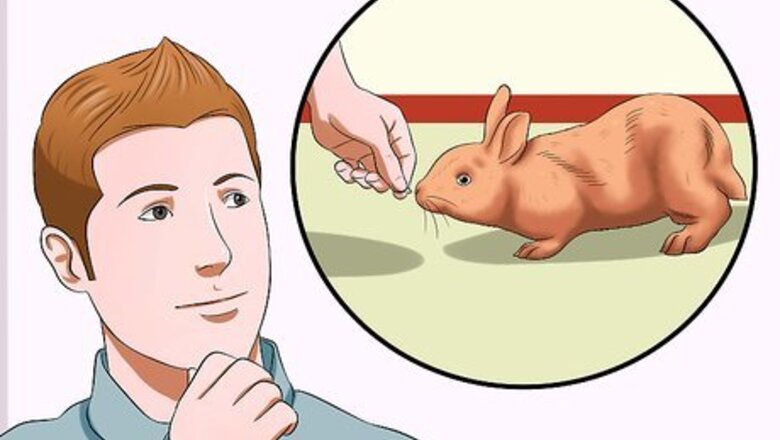
views
X
Research source
Since chewing is a necessary and natural activity for your rabbit,[2]
X
Research source
he may have developed a bad habit of chewing your carpet. Although training him to stop chewing carpet can be frustrating, there are different things you can do to divert his attention away from your carpet.
Making the Carpet Undesirable to Your Rabbit
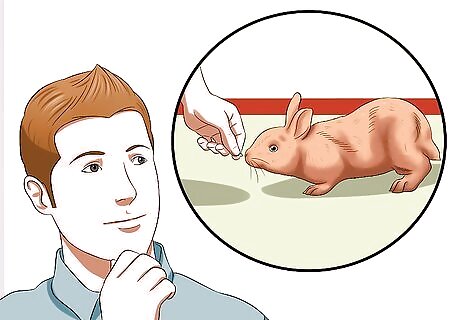
Learn about how to train a rabbit. Rabbits are very intelligent animals, and are quite capable of being trained. However, unlike dogs, rabbits do not aim to please their owners and can thus be difficult to train. They do not have a natural instinct to obey, so your rabbit will not stop chewing the carpet simply because you tell him not to. Training your rabbit to stop chewing the carpet will involve not only making the carpet undesirable, but also redirecting his chewing behavior towards something more appropriate. Positive reinforcement is an important component of training your rabbit. Rewarding him when he chews on something more appropriate, through such activities as head scratches and extra petting, will help train your rabbit to stop chewing carpet.

Put furniture over the carpet. Training your rabbit to stop chewing carpet primarily involves making it undesirable or unattainable to him. One way to do this is to block his access. When your rabbit is chewing the carpet, pay attention to where he tends to chew. After identifying the problem area, find ways to keep your rabbit from that location, such as covering the area with a big piece of furniture (e.g., couch, reclining chair).
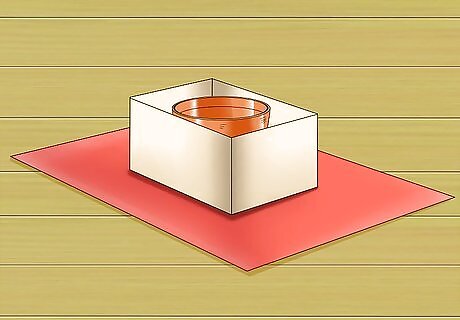
Cover the carpet with small items. If moving heavy furniture is not practical for you, place smaller objects in the area where your rabbit likes to chew. For example, cover the problem area with heavy ceramic tiles. The tiles would hold the carpet down and prevent your rabbit from getting a hold of the carpet. You can also cover the area with a cardboard box. Weigh down the box with something heavy inside, such as an empty flowerpot, so your rabbit can’t push it out of the way. Place some ‘digging’ material (e.g., shredded newspaper or magazine) in the box to foster your rabbit’s natural digging habit. Place some rugs in the problem area. Make sure the rugs are made of natural material in case your rabbit decides to chew on them. If your rabbit can’t get to the carpet, he will eventually get bored and forget about the area altogether. Covering the area with different objects is a temporary solution. If you choose, cover the areas only when your rabbit is playing outside of his cage.
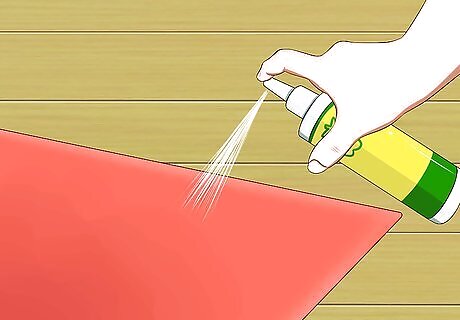
Make the carpet taste bad to your rabbit. If blocking access is not possible, you can make the carpet taste bad enough for your rabbit to stay away from that area. For example, spray bitter apple spray in your rabbit’s favorite chewing location. Bitter apple spray is available at your local pet store. Ivory soap can also keep your rabbit from chewing the carpet. Your rabbit won’t get sick from eating the soap, but he probably won’t like the taste. Break the soap into small sections and spread it along the area of carpet where your rabbit likes to chew.
Giving Your Rabbit a Chewing Alternative
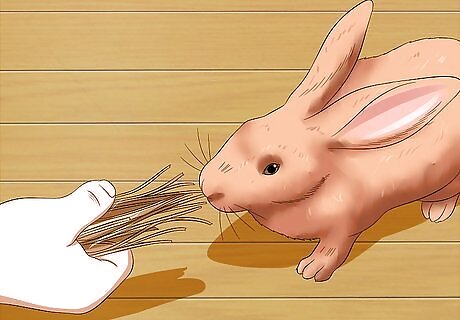
Give your rabbit hay and grass. Chewing is not only a natural and normal activity for rabbits, but is also necessary to keep their teeth worn down. In addition to training him to stop chewing your carpet, you will need to give him chewing alternatives, such as fresh hay and untreated grass. Good types of hay are orchard grass, oat, and timothy. Replenish the supply a few times a day. Grass mats, which are available at your local pet store, are also good for your rabbit to chew on. The grass should be untreated to prevent your rabbit from ingesting harmful chemicals. Compressed alfalfa cubes make another great chewing alternative.

Provide your rabbit with chew toys. Rabbit-specific chew toys, such as wooden chew sticks, will also keep your rabbit from chewing your carpet. Willow sticks and wicker toys are other good choices. Examples of other chew toys are willow bridges, willow balls, and a hideaway made of wicker or grass. Make sure the wooden toys are made with untreated wood to prevent your rabbit from ingesting harmful preservatives or varnishes. Be aware that the willow or wicker in home decoration stores are often covered with these substances. Rabbit-specific chew toys are available at your local pet store.
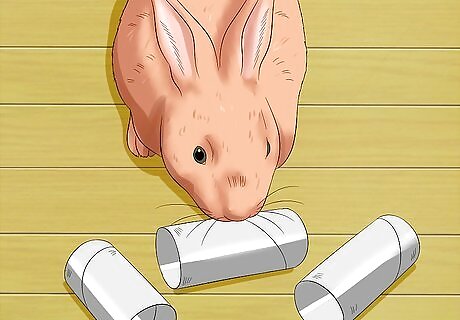
Find free chew toys for your rabbit. You do not have to spend money on chew toys for your rabbit. Chances are you have some household items for him to chew on. For example, empty toilet paper rolls and cardboard boxes make great chewing alternatives. Make sure the cardboard box does not have any heavy ink, varnish or staples. To keep your rabbit entertained, stuff some hay or grass into the toilet paper roll. Old blankets and cotton towels also make good chewing alternatives.
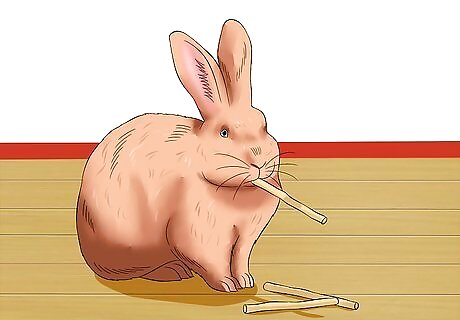
Give your rabbit tree branches to chew on. Your rabbit will love to chew on branches. However, you should not go out and randomly pick some branches from the trees in your yard—they may be toxic to your rabbit. Know which branches are safe and unsafe for your rabbit. Rabbit-safe woods include willow, apple, maple and birch. Unsafe woods include cherry, holly, yew, and rosewood. Some fruit tree branches (apricot, peach) are toxic only when they are attached to the tree. After the branches are cut and dried for about a month, they will be safe for your rabbit to eat. If you decide to pick branches from your yard, pick a tree or bush that is far away from the road and exposed to less car pollution. If you are unsure if the branches in your yard are rabbit-safe, visit your local pet store or home gardening store to purchase branches.

Replace the chewing alternatives regularly. House rabbits often resort to chewing carpet when they are bored or frustrated. To keep your rabbit interested in the chewing alternatives, switch them out every few days. Consider giving your rabbit a variety of toys each time you replace them. Replace any chew toys that start to show signs of wear and tear.
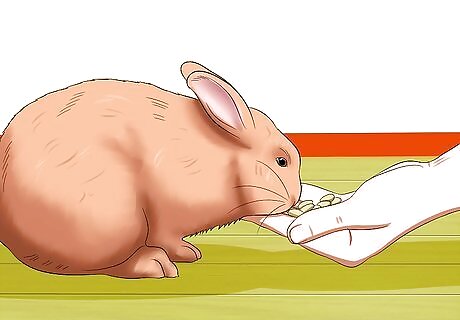
Praise your rabbit when he chews on the chewing alternatives. Disciplining a rabbit for bad behavior (e.g., clapping hands, saying ‘no’) is usually not very effective. Instead, give him praise and positive attention when he chews on what you have given him. Not only is discipline ineffective, it can also be stressful to your rabbit. If you try to punish him after you see him chewing the carpet, he will not know what he is being punished for and will feel stressed. Rewards can take the form of verbal praise, extra petting, and healthy treats.
Playing With Your Rabbit
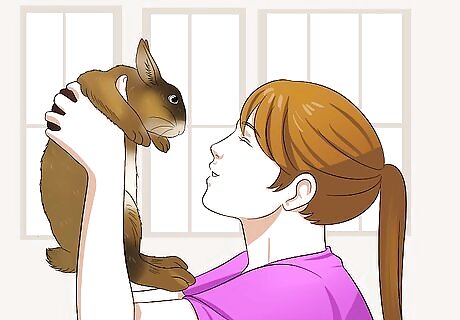
Play with your rabbit regularly. Rabbits are intelligent and social animals. Without attention and activities to keep him mentally alert, your rabbit can develop destructive habits, such as chewing carpet, to get your attention. Playing with your rabbit each day will give him the attention and mental challenge he needs to stay occupied and away from carpet chewing. The mornings and evenings are good times to play with your rabbit. Do not interrupt your rabbit to start playing with him. For example, if he is eating or grooming, let him finish that activity before starting playtime. You can even leave the cage door open so he can come out to you when he’s finished and ready to play. When you play with your rabbit, get down on his level so he will feel comfortable with you. Although he may not necessarily want to jump in your lap, he will feel safer if you are not towering above him.

Set up a play area for your rabbit. Rabbits must have playtime outside of their cages each day. Not only does this give you an opportunity to interact with your rabbit, but it also gives him some much-needed exercise. Put a variety of toys in the play area, along with different items that your rabbit can dig in and chew on. Always supervise your rabbit when he is playing outside of his cage. ‘Rabbit-proof’ the area by removing or covering electrical cords and covering wooden furniture legs with plastic or bubble wrap. Leaving a play area set up for your rabbit can keep him busy and physically active when you are away from home.
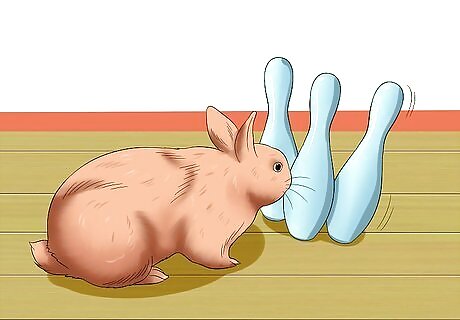
Play different games with your rabbit. Your rabbit may have the best toys in the world, but that doesn’t mean he should always play alone. Come up with different games that you can play with him. For example, play fetch with your rabbit, during which you are the one catching the toy. Rabbits like to pick up toys with their teeth and toss them across the room with a flick of the head. Small toys for birds are good for playing fetch. Try bowling with your rabbit. Purchase some plastic bowling pins and set them up in the play area. Your rabbit will enjoy knocking the pins down with his nose, and you will have fun watching him do it. Let your rabbit ‘steal’ things out of your hand and run away with them. This may not seem like much a game, but it will certainly keep your rabbit entertained. Choose an object that you wouldn’t mind your rabbit stealing, such as a piece of junk mail.

Give your rabbit a playmate. In addition to playing with you, your rabbit may also enjoy playing with another rabbit. Having another rabbit to play with could keep your rabbit from getting too bored or frustrated. If your rabbit doesn’t seem to enjoy playing as much as he used to, a rabbit playmate could help get him excited about playing again. When you are looking to buy another rabbit, consider taking your rabbit along with you. Purchase the other rabbit through a shelter or rescue group rather than a pet store. Rabbits in pet stores typically come from mass-breeding facilities and can have digestive problems. The staff at the rescue group or shelter can teach you how to introduce the rabbits and determine if they are a good match for each other.
















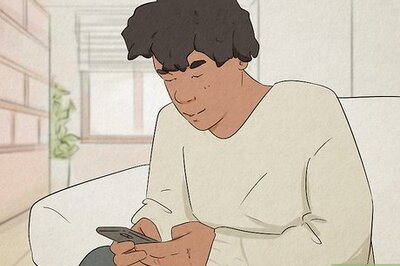



Comments
0 comment